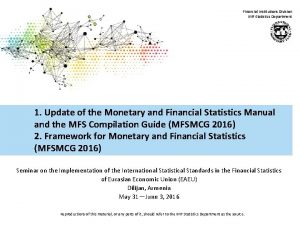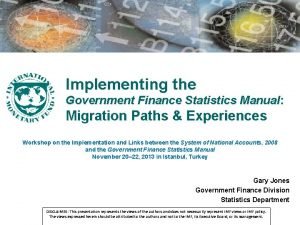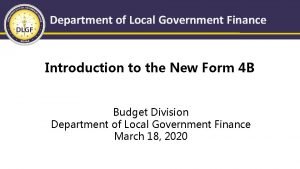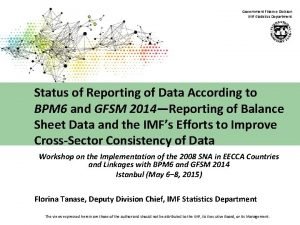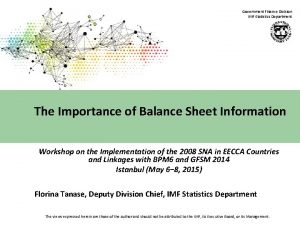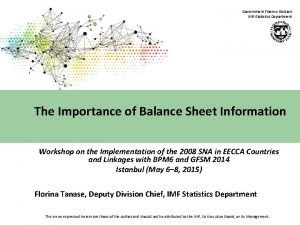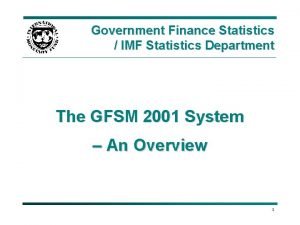Government Finance Division IMF Statistics Department The Use















- Slides: 15

Government Finance Division IMF Statistics Department The Use of Indicators on Deficit and Debt 9 th Meeting of the Advisory Expert Group on National Accounts September 8– 10, 2014, Washington D. C. Claudia Dziobek, Chief - IMF Government Finance Division Tuesday, September 9, 2014 (Afternoon Session-Item 14) Reproductions of this material, or any parts of it, should refer to the IMF Statistics Department as the source.

Government Finance Division IMF Statistics Department Overview § GFS and National Accounts § Availability of International Guidelines for Debt Data § § § Compilation Sources of Differences in Debt Data A Cascading Approach to Presenting Debt Data Way Forward 2

Government Finance Division IMF Statistics Department GFS and National Accounts § GFSM 2014 aligned with 2008 SNA § Government a major sector § GFSM 2014 framework requires additional information to NA data for more detailed fiscal analysis e. g. , • • • Different aggregates (revenue, expense, expenditure) Detailed breakdown of taxes, subsidies, other government revenue Consolidation § IMF GFS questionnaire seeks more detailed information that available from NA compilation. 3

Government Finance Division IMF Statistics Department GFS and National Accounts § GFSM Framework has four alternative measures of the deficit / surplus: • • Net/gross operating balance Net lending/net borrowing (NLB) Cash surplus/deficit Total financing § Other surplus / deficit indicators are also widely used e. g. • Primary balance (or primary surplus / deficit) • Structural / cyclical balances § All these indicators provide an indication of the in-year fiscal position. 4

Government Finance Division IMF Statistics Department GFS and National Accounts § Government gross debt a key fiscal indicator: • Defined as a subset of total government liabilities – six debt instruments v v v Debt securities Loans Currency and deposits SDRs Other accounts payable Insurance, pension and standardized guarantee schemes § For debt statistics, analytical need for debt at different valuations (not just market values) 5

Government Finance Division IMF Statistics Department Availability of International Guidelines for Debt Data Compilation § International guidelines for compiling debt well established: • • • Government Finance Statistics Manual 2014; Public Sector Debt Statistics: Guide for Compilers and Users; and External Debt Statistics: Guide for Compilers and Users (EDSG), 2011. § In practice, differences in debt data limit cross country comparability 6

Government Finance Division IMF Statistics Department Sources of Differences in Debt Data § Differences arising from: • Institutional sector coverage – central government? general government? public sector? other? • Debt instrument coverage – just debt securities and loans, or wider coverage of debt instruments? • Valuation – market, nominal, or face value • Consolidation - consolidated or unconsolidated debt? 7

Government Finance Division IMF Statistics Department Sources of Differences in Debt Data Institutional Sector Coverage Includes State and Local Canada’s Gross Debt by Sector (in percent of GDP) 139% 106% 49% Source=World Bank/IMF /OECD Quarterly Public Sector Debt Statistics Database 8

Government Finance Division IMF Statistics Department Sources of Differences in Debt Data Debt Instrument Coverage Australia: Debt Instruments (in percent of GDP) Note magnitude of Pension Liabilities Source = Government Finance Statistics Yearbook (GFSY) 9

Government Finance Division IMF Statistics Department Cascading Approach to Presenting Government Debt Data Levels of Government Aggregations of Debt Instruments § GL 1 – Budgetary Central § D 1 – debt securities and loans § D 2 – D 1 plus SDRs and currency Government § GL 2 – GL 1 plus extrabudgetary units and social security funds § GL 3 – GL 2 plus state and local governments § GL 4 – GL 3 plus nonfinancial public corporations and deposits § D 3 – D 2 plus other accounts payable § D 4 – D 3 plus insurance, pensions and standardized guarantee schemes § GL 5 – GL 4 plus financial public corporations 10

Government Finance Division IMF Statistics Department Cascading Approach to Presenting Government Debt Data 11

Government Finance Division IMF Statistics Department Country Examples: China P. R. Hong Kong Very low levels of debt in D 1 -D 3 – most debt is employment related pensions for civil servants 12

Government Finance Division IMF Statistics Department Country Examples: Iceland Major increase in Icelandic debt is from D 3 to D 4 at all levels of government GL 3/D 3 = 105 percent of GDP GL 3 / D 4 = 132 percent of GDP 13

Government Finance Division IMF Statistics Department Country Examples: USA Some debt securities issuance by State and Local Governments – emphasizes importance of general government data D 1/GL 1 is 79 percent of GDP. D 4 /GL 3 is 122 percent of GDP 14

Government Finance Division IMF Statistics Department Way Forward § The IMF is adopting the cascading approach in the recently updated questionnaire to collect data from member countries for publication in the 2014 GFSY • Countries or regions are also allowed to disseminate a debt aggregate using their national definitions of debt § The same approach is adopted for the presentation of government/public sector debt data in the World Bank/IMF/OECD Public Sector Debt Statistics database 15
 Imf financial statistics
Imf financial statistics What is financial assets?
What is financial assets? Government finance statistics manual
Government finance statistics manual Department of local government finance
Department of local government finance Imf history
Imf history Imf adalah
Imf adalah Concept of imfa
Concept of imfa Difference between imf and world bank
Difference between imf and world bank Materi lembaga keuangan internasional
Materi lembaga keuangan internasional Membership of imf
Membership of imf India imf loan history
India imf loan history Imf practice
Imf practice Wto objectives
Wto objectives Imf chemistry
Imf chemistry Imf system
Imf system Debt imf
Debt imf

